
Eleven years is a long time. As the last few months have proved, an awful lot can change in a short period, and that's doubly true when it comes to game development. Following over a decade of working on separate projects as different companies, you'd be forgiven for thinking that 'getting the band back together' for The Outer Worlds would come with certain challenges, or at least a lengthy adjustment period.
"It took very little time," writes Tim Cain, creator of the Fallout series and co-game director on Obsidian's 2019 action RPG which reunited him with fellow Fallout veteran and key designer Leonard Boyarsky for the first time in over a decade. "We still laugh about how quickly we picked up where we left off, almost as if the intervening 11 years had never happened. I say “almost”, because both of us had learned hard lessons by working at big companies on big games, so we had several new design techniques to avoid pitfalls and gotchas."
both of us had learned hard lessons by working at big companies on big games, so we had several new design techniques to avoid pitfalls and gotchas.
Following a delay from the end of March, The Outer Worlds can now be played on Nintendo's console. The game gave Cain and Boyarsky the opportunity to fashion a totally new IP, although one infused with the same spirit of their past games.
With so much shared history and a great working partnership, it didn't take long to get into the flow again. It was April 2016 when the game began development, and it shipped on PC, Xbox One and PlayStation 4 three-and-a-half years later. Having been totally involved from the very beginning, we asked Cain about his favourite stage of the production process.
"That’s a tough question, because there are things I like at every stage, from “the sky's the limit” beginning to the “wow, look what we made” final stage. But I guess I like one of the stages in the middle, when you have the whole team hired and everyone is on the same page design-wise and understands what the game is going to be."
"That’s a great time because people are creating lots of things in parallel, and every day you see something new in the game. Maybe a new mechanic was added, or a new creature is available, or a new map is ready to explore. The game doesn’t look or play like the shipping version (the lighting usually isn’t in, there are placeholder creatures and quests, and lots of bugs and crashes), but I love it anyway. It’s when I feel the most creative and when everyone on the team is sharing the most with each other."
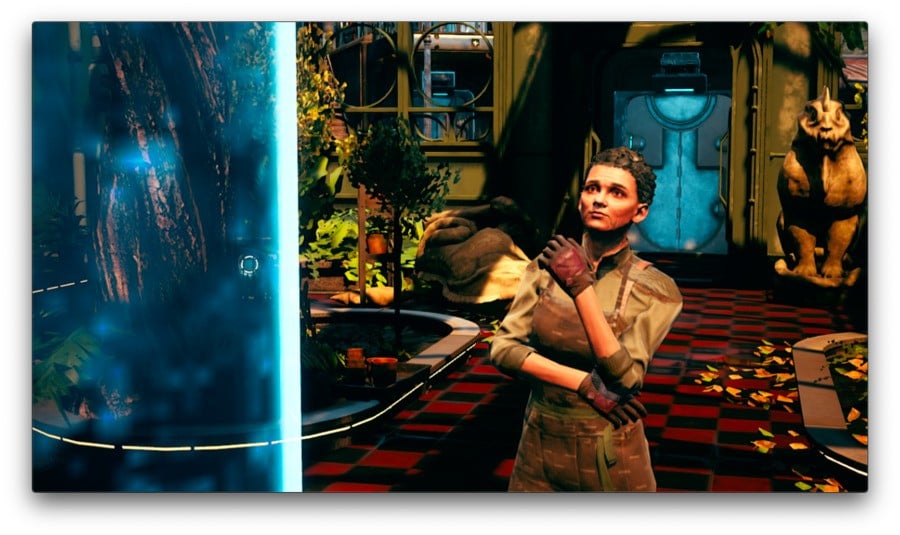
The pulp sci-fi themes of The Outer Worlds gives it a distinctive feel that comes from Cain's personal influences. "I grew up with the books of the Golden and New Wave ages of science fiction, from the 1950’s through the 1970’s, because that was what my local public library had to offer. Plus a few before and after. I’d say the writers who influenced me the most were Asimov, Banks, Clarke, Heinlein, Ellison, Herbert, Le Guin, Niven, Silverberg, Simak, Simmons, Stapledon, Vance, and Zelazny. Not in that order. In fact, I alphabetized them to hide the order I remembered them in."
Despite the pulpy space opera angle, the flavour and spirit of Fallout is readily felt in The Outer Worlds, from broad-stroke themes down to gameplay mechanics like Tactical Time Dilation, a combat system that enables the player to slow down time. For fans, it's a treat to see Cain and Boyarsky returning to this style of game, but we wondered if there was any concern about retreading familiar territory. Were they hesitant to revisit themes they'd explored in the past?
"After Fallout, Leon and I made Arcanum, which also had a strong Fallout vibe in look and feel, if not in setting. After that came out in 2001, you could say that post-apoc was out of our systems, and we made games that explored new territory for us, like Vampire Bloodlines and Temple of Elemental Evil. Then I worked on a sci-fi MMORPG and Leon worked on Diablo 3."
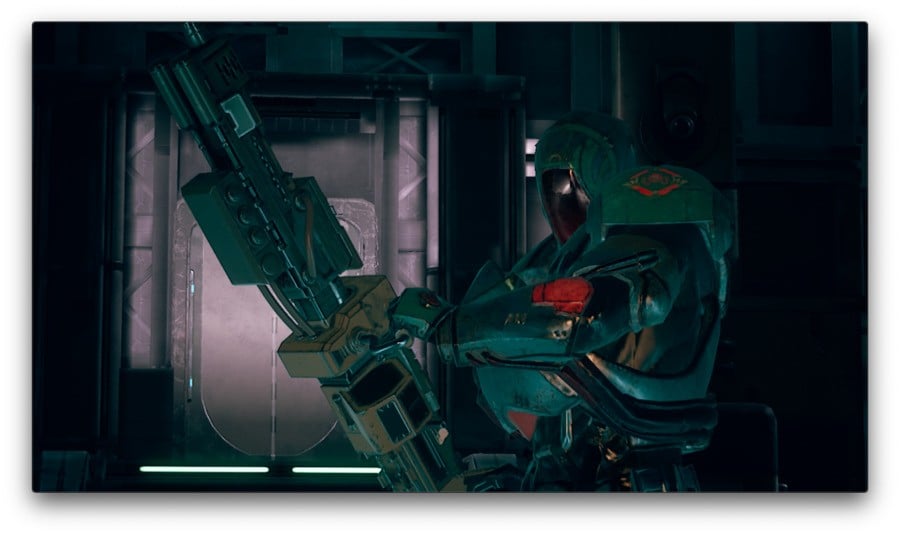
"So when we got back together in 2016, fifteen years had passed since we had done anything Fallout-like. We were given Fallout and Firefly as touchstones for our new game, and we felt ready to dive back in and see what new things we could bring to the table."
We were given Fallout and Firefly as touchstones for our new game, and we felt ready to dive back in
With such a rich back catalogue of titles, we asked if there were any ideas or elements they weren’t able to make work in the past that came to fruition in this game. "Sure!" he replies. "I had been trying to make a flaw-like game mechanic since the original Fallout." The Outer Worlds features a Flaws system - a selection of negative (and permanent) attributes that manifest as options if you die a number of times in the same manner. Choosing a Flaw rewards you with a perk point, so there is a benefit to accepting one.
It's a mechanic Cain had been wanting to implement for a long time and The Outer Worlds provided the perfect opportunity to realise a system that had never quite worked before. "It either never felt right or it was shot down by other developers. I’d like to say that they failed to see the magnificence of the design, but really, the mechanic just wasn’t ready yet, and for some of those games, it wasn’t a good fit."
Compared to some of their previous games, The Outer Worlds was a smaller project that ended up much grander than its modest resources might suggest, largely thanks to the skills of Obsidian’s veteran team. However, its reduced size meant it was necessary to scale back the scope and ambition of the team's vision.
"Because of relatively tight time and budget, compared to AAA games, we constantly had to scope down," says Cain. "That meant fewer characters and areas, less variety in creatures and armor and companion abilities, and an overall shorter game."
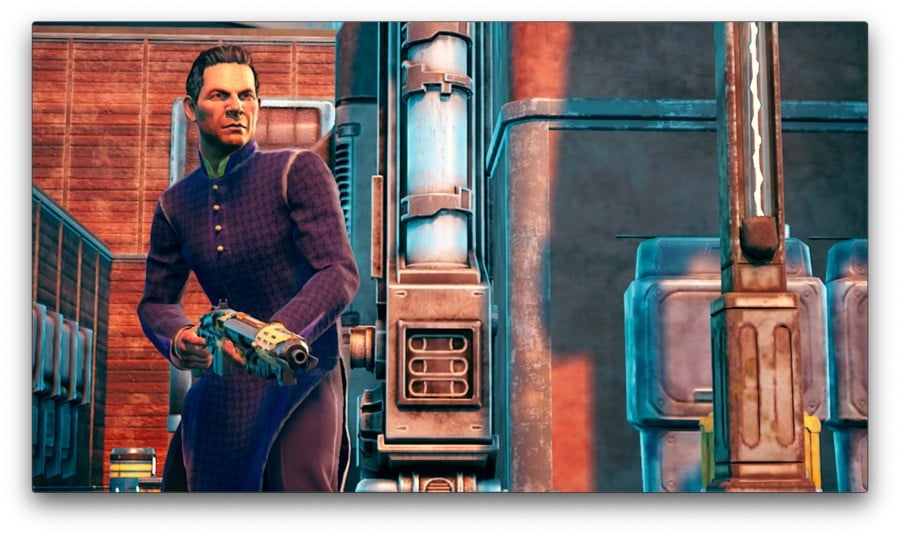
This reduced scope and shorter length didn't much harm the warm critical reception when it released in October 2019, though; the game was nominated for multiple awards that year in a variety of categories, with its writing highlighted for particular praise.
Naturally, Switch owners were excited to hear news of a port courtesy of Virtuos, the studio behind a variety of excellent Switch ports, including L.A. Noire, Dark Souls: Remastered and, more recently, XCOM 2 Collection and BioShock: The Collection. Speaking via email, the game's production director Eric DeMilt had nothing but good things to say about the company, and reiterates that it was Virtuos' proof-of-concept that persuaded them a Switch port could really work.
"The team at Virtuos have been great to work with," says DeMilt. "Their prototype was excellent and did convince us that they were the right developer to bring the game to the Switch. The partnership with Virtuos and Private Division has been, and continues to be, excellent throughout the process. From day one, all teams were in close contact, sharing information, asking and answering questions, playing and testing builds and iterating every step of the way."
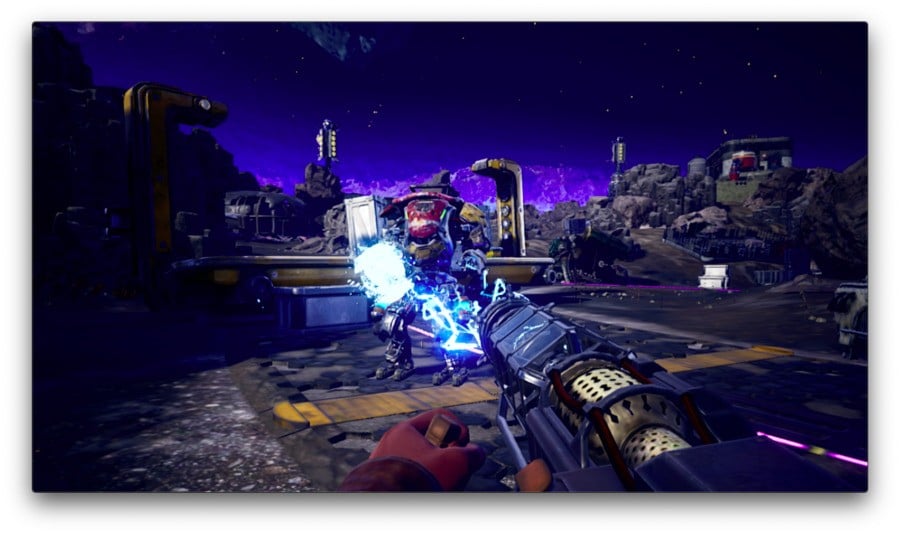
The Outer Worlds was originally set to launch on Switch back in March, although the COVID-19 pandemic altered those plans, with Virtuos experiencing repercussions that people and companies all over the world have dealt with to a greater or lesser extent over the past months.
we had a preview into this new reality as we watched our partners go through things weeks before we did
"The COVID-19 pandemic has changed nearly everyone’s day-to-day life and work experience," DeMilt says. "Fortunately, we work in an industry that has been able to work-from-home globally and have been much less impacted than many. We got our first look at what a post-COVID world might look like through the Virtuos dev team. China went through the lockdown and recovery process much earlier than we did here in the US, so we had a preview into this new reality as we watched our partners go through things weeks before we did."
It seems that once the lockdown did eventually reach US soil, the company was better prepared than it might have been otherwise. "In addition to what we were learning from the Virtuous team, Obsidian leadership and the leadership team at Microsoft were paying close attention to public health officials and were preparing for what was to become our new reality. This, plus a ton of hard work by our IT team made the transition to work from home a relatively smooth one. I think it was ~48 hours, from the point at which Feargus [Urquhart, Obsidian Entertainment Studio Head] made the call to transition to work from home, to when we had 100% of the employee population off site and mostly up and running. It’s been a challenge, like learning new ways to meet and communicate, but so far it has been a success."
On the topic of Microsoft, Cain says that things changed very little for him and Obsidian following the company's 2018 acquisition. "Microsoft’s purchase of Obsidian had very little impact on our day-to-day work lives. We were already developing the game for Private Division, and they were the ones who judged the milestones and suggested changes. Other than once or twice in a group setting, I never even spoke to anyone from Microsoft while making The Outer Worlds."
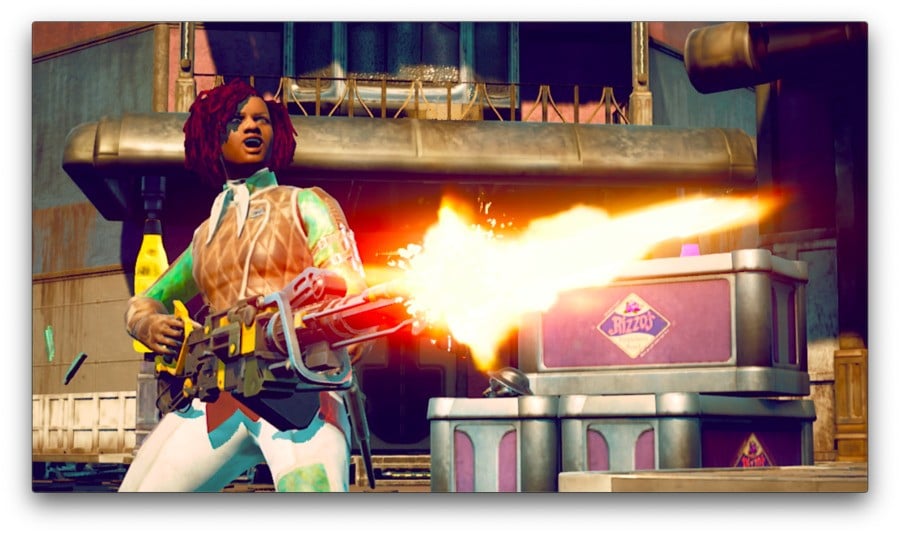
With a decades-long career that began back at Interplay in the early 1990s, we wonder if there is any aspect of development from ‘the old days’ that Cain misses. After all, the tools and methods employed to make the original Fallout must have improved dramatically over the last quarter-century. What are the biggest improvements to the way he approaches making games nowadays?
"Aside from the fact that fully realized game engines are available, some tool chains are much more mature now than 25 years ago. Making complex conversations and tracking our hundreds of thousands of lines of text for localization is so much easier. Audio, from effects to music, is also easier for audio designers to add to the game, without taking down a programmer every time they wanted something new."
"The biggest development aspect I miss is the faster development cycles in older games. We could test out a new feature, from concept to implementation to testing, in a fraction of the time it takes now, and with far fewer people that the feature has to pass through. These fast cycles meant more ideas could be developed and make it into the final game in the same time period."
The biggest development aspect I miss is the faster development cycles in older games. We could test out a new feature, from concept to implementation to testing, in a fraction of the time it takes now
We ask if he has a personal favourite character build or playstyle in The Outer Worlds, or if after so many playtests he just goes with the flow. "I usually like dumb playthroughs and sniper playthroughs (and sometimes dumb snipers), but on this game, my favorite build was Dr. Leader, a low-dexterity, high-charisma character who tagged the Tech and Leadership skill categories. I specialized in finding all of the Science weapons, and myself and my crew were decked out in the highest tinkered weapons and armor in the game."
In the time since Switch launched back in 2017, the console has become an unlikely home to several excellent classic RPGs, including a brilliant port of Pillars of Eternity, another Obsidian joint. The sequel, Deadfire, is scheduled to arrive on Nintendo's hybrid later this year, and we wondered if Obsidian will continue to support the platform in the future. DeMilt says that it is down to the publishers to decide where the team's games end up.
"For us, as a developer, the decision of what platforms we support is pretty much out of our hands. The Outer Worlds is published by Private Division, they’ve been excellent partners and involve us in decisions like this, but at the end of the day it is their call."
However, DeMilt hints that should the Switch port sell well, Obsidian has ideas and the desire for more adventures in The Outer Worlds on Nintendo's platform. "I hope that both Private Division and Switch players want to see more Outer Worlds content on the Switch in the future."

Enthusiasm for the hardware amongst developers has been key to Switch's success, and that's certainly the case for both Cain and DeMilt. "The Switch is a great piece of hardware," says DeMilt. "It is really cool to see a full featured “Obsidian RPG” like The Outer Worlds running on a handheld, and to be able to take that experience with you wherever you want to play it."
"I have been playing Luigi’s Mansion 3," Cain tells us when asked what he's been playing in his free time. "And Skyrim on my Switch (I seem to return to Skyrim every couple of years, on different platforms and trying different builds). I’m also playing a lot of Minecraft. I find it very relaxing."
Looking ahead, the Pillars of Eternity sequel is already out on other consoles and Switch-bound. With more Outer Worlds content potentially in the works, it seems we haven't seen the last of Obsidian on Nintendo's console, but we wonder what the future holds for Tim Cain specifically.
"I hope a great deal of dark chocolate."
Our thanks to Tim and Eric for their time. The Outer Worlds is out now on Switch - find out the NL verdict on Virtuos' port in our review.



Comments 35
I can’t wait to play The Outer Worlds. Even with its issues it still got an 8/10 here which is very impressive. And critics seem to agree, the game is super fun on Switch.
The writing’s really a standout. Even with its short length, some of those companion quests will stay with me for a long time. I genuinely believe Parvati’s questline is one of the best in any RPG of the 2010s. They made a great decision not adding dating mechanics, it makes you feel like your character has the crew’s best interests at heart instead of how Shepard is constantly trying to get into everyone’s pants!
Maybe I'm just easily pleased, but I watched a few vids of this game, side by side comparison with XBox ones, and all the comments were slating the graphics (PS2 era, etc, etc). I honestly couldn't see a huge difference. Certainly not enough to warrant some of the flak it was getting.
@Lordplops I watched the same comparison videos. To me there was quite a noticeable difference but I don't care. I'm fine with putting up with the downgrades to have it on the go. Hopefully the random loads can be addressed with another patch though.
It was an alright game but not very standout for me personally. I guess I was just expecting a lot more for some reason. It was still pretty enjoyable though.
Cancelled my order after hearing that it drops to 15 FPS, that is just unaccaptable. After Witchere 3, the standard should be much higher.
@TAndvig after hearing lol I'm glad I came from 80s gaming when you played what you wanted not based on someone else's opinion.
@Darkyoshi98
While that's true, I agree with @TAndvig that it dropping to 15 FPS is unacceptable, no matter what game it is.
Yeah, the DigitalFoundry video also cited several instances where the enemy AI just stopped doing anything and stood there waiting to be shot, which seems like a pretty big non-cosmetic downside to the port.
At least gonna wait for some patches.
Yup sadly the port is horrendously bad sad I was looking forward to play it.
@Darkyoshi98 "I came from 80s gaming when you played what you wanted not based on someone else's opinion."
Then what were all of those video game magazines with reviews for a million games for?
Interesting that Microsoft has been so hands-off. Got to wonder what that will mean for Xbox exclusives down the line - hopefully better working conditions. Can’t imagine Sony not leaning on its first-party studios with every kilo of weight it has.
Really hope The Outer Worlds gets a patch or two down the line to bring it up to snuff. Switch could do with more top-tier WRPGs - even if the developer does prefer dark chocolate. Ew.
@nintendoknife not really anything to do with the point you are making but damn, I miss those magazines. Mean Machines was just the best.
@Lordplops I miss those days too. I would buy Electronic Gaming Monthly every so often. I remember one in 2001 or 2002 that rounded up the worst games of the year. My buddy and I were in tears laughing from the great writing.
I'm curious enough to take a look, always appreciated Obsidian's work on New Vegas, and Pillars of Eternity is a decent little title. I wouldn't mind if they encouraged anyone they may still be friendly with over at Bethesda to bring the Fallout series to Switch, while they're at it. So far it seems Bethesda is bringing everything but the two IPs of theirs I really want on Switch (Fallout and Dishonored). Bring them over, please!
@Menardi agreed!
@ACNHislit Oh no, don't agree with me. Apparently listening to others is a nono.
@Darkyoshi98 ....You are commenting "That" on a journalistic news site....Do you see the irony here?....eyeroll
I really want to play this game... when it gets patched.
@Lordplops while I haven't played this on switch yet. I did play it on PC and it was easily one of the top 2 have in 2019 for me
@Darkyoshi98 let's hear it for 80' era gamers
@TAndvig
Why is agreeing with you a bad thing? You didn't come off harsh or trolling at all, at least to me. There's a difference between listening to someone's opinion, and not changing your opinion because of someone's review, opinion, or comment.
While I'm not a FPS Geek, I think it should be at least a stable 30 FPS.
@ACNHislit It was just sarcasm, since the guy apparently believes that listening to others is a bad thing.
@TAndvig Right, games should be much better than TW3 in all aspects before they can be considered good. That was a truly awful game, easily one of the worst this gen.
Anyway, Outer Worlds just hasn't gotten its hooks into me yet. I keep trying to find a reason to care about the world and keep playing. Oh well, proves my long-standing point; never buy a game because it's on sale, if it wasn't worth full price then a cheaper price tag won't make it more enjoyable. Amazing how some people can justify that, as if the mechanics or quality change because it's cheaper.
@TAndvig
Oh, haha. 😆
I'm not the best with picking up on sarcasm, especially if it's over text (or comments).
Great interview, with true legends in the genre!
It's a little ironic that Tim loves Elder Scrolls games, yet the Elder Scroll's team's take on his own Fallout misses the mark by a galactic mile.
@ErraticGamer I got it on launch and so far haven't seen a single issue of the framerate drop or bad enemy behavior, been on three worlds and 100%'d each of them - kind of weird seeing the reviews vs. actual performance (with that said, handheld is a drop-down from docked, visually)
The port is bad but I still find it quite enjoyable on the Switch. The game is perfectly playable even without the patches.
It's a solid game to be fair, 7.5 out of 10 easily. It's slightly better looking elsewhere but really that's a small sacrifice to make to have it portable and the only downgrade is the graphics. In terms of everything else, it's all there and certainly worth the money.
Easily 50-60 hours of content here which is worth their asking price.
"Brilliant port of Pillars of Eternity"
Right....games is broken, crashes far too much.
Just got this game. I like rpgs but big time sinks can be intimidating especially if they dont reward you enough.
Not an issue with this game. There are so many fun customizations, options, and upgrades that no moment feels wasted. To say this game is fun is an understatement.
Minecraft is a great RPG, maybe the best...but it's a terrible videogame.
This game received a patch not long ago, right? How does it look and run now? Is it worth it already, or do you reccomend to wait for another bigger patch?
@the_beaver I recently bought a used copy of Outer Worlds on Switch, as good as new (the points weren't redeemed even), for about €20.
There's a great game here, that at times is quite beautiful as well. There were some moments I could hardly see where I was going (inside a dark building with VERY blurry and muddy textures in a very "detailed" environment (that just couldn't properly load) as part of a very big map with many enemies around. But those moments are rare, and didn't break the game, only the immersion.
I also did not like the amount of quite long loading screens it took when finishing up some quest lines later on using fast travel (it has to load the ship, you then have to select what planet to go to, and then it has to load that area; if you're unlucky you then have to travel to a separate area that needs to be loaded, taking up several minutes of no fun whatsoever. I've literally fallen asleep when doing that late at night).
Those issues aside (of which one is definitely partly due to the hardware limitations, the other is more game design but not helped by weaker hardware) it was a great experience, taking up way more hours than I'd be willing to sit watching at a tv, so it was Switch or nothing anyway. The patches appear to have done quite some good as well, but I haven't actually PLAYED it before the last one, only seen videos of it. It still has some issues, but they are minor and can't bring down the better parts of the game. Another one would always be welcome, but the game is definitely enjoyable as it is now.
@Shambo That's good to hear, thanks! I really hope they fix the eternal loading screens, I hate them... But if, like you, I find the game for a good price, I might give it a chance.
Tap here to load 35 comments
Leave A Comment
Hold on there, you need to login to post a comment...